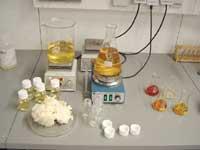Is biodiesel a clean fuel?

Compared to diesel fuels derived from oil, biodiesel has numerous advantages, not only environmental, but also energy and economic.
It offers new business opportunities to the rural environment, for example. Biodiesel can be obtained from raw materials such as fatty seeds (sunflower, rapeseed, soy and coconut), fatty fruits (palm), high acidity olive oils, animal fats, etc. Therefore, in agricultural lands, rape, sunflower, etc. working, farmers have a new opportunity to sell them. In addition, taking into account the regression suffered by the rural environment in recent years, biodiesel could be a way to create new markets, income and jobs.
On the other hand, biodiesel emits less polluting gases than conventional diesel. This can be an appropriate fuel for cities with polluted atmosphere, as well as areas where air renewal is difficult, such as mines.
Pure biodiesel has low toxicity in water and is biodegradable disappears completely in 30 days. These features make it a safer fuel for accidents, even in groundwater areas. Incidentally, it should be noted that when biodiesel is mixed with diesel, it degrades three times faster.

And if we look at cooking oils, what? Do not forget that it allows recycling the oil used to fry every day around the world. Of course, it cannot be said that everyone can become biodiesel, but some can. The use of these oils in restaurants, hotels, houses, etc. is continuous and poured without special treatment. These discharges contaminate the water because when oil accumulates on the surface of the water the exchange of oxygen is less.
Why biodiesel?
Biodiesel can be used by many vehicles. Various studies conducted in Europe, USA, New Zealand and Canada indicate that it can be used in trucks, cars, locomotives, buses, tractors and small boats. Studies have been conducted using pure biodiesel and biodiesel and common diesel blends.
Results have shown that engine wear decreases and engine performance does not vary. The reason for reducing wear lies in the ability of biodiesel to lubricate. On the other hand, biodiesel would reduce the import of petroleum fuels and could be a way to avoid dependence on oil suppliers.

Biodiesel, unlike other alternative fuels, does not force diesel engines to change. Regardless of the percentage of biodiesel mixture, or using pure biodiesel, it can be used on all conventional diesel engines. However, keep in mind that biodiesel can cause engine cleaning. That is, it can remove any dirt that could exist in exhaust pipes, diesel tanks, etc. of a car that used diesel, and when passing through the tubes can cover the tubes and create problems.
Nothing is perfect or biodiesel
So far we have mentioned the advantages of biodiesel, and it seems that it has no difference. That is not true.
If the process of obtaining biodiesel is strictly observed, glycerin that is formed as a side product can cause problems. Although this material is used for other industrial processes such as soap manufacturing, overproduction would generate surpluses. These glycerin surpluses can become a problem for nature, as with the rest of the surpluses, due to the absence of pouring. In addition, the elimination routes of these surpluses, such as burning, would increase the cost of biodiesel.

Biodiesel can also involve specialization of agricultural land. The consequences of planting the same crop on land, such as deforestation, are known. Therefore, for the production of biodiesel it is necessary to rotate crops on the land and adopt measures that guarantee biodiversity.
On the other hand, for the transport of biodiesel, as with many other fuels, so far it has been thought exclusively of road transport. This would increase the number of vehicles on the roads, so alternative means of transport are needed.
Please note the material to be used for storage. Copper, brass, lead, tin and zinc are not recommended. The most suitable tanks are aluminum, steel, fluorinated polyethylene, fluorinated polypropylene and teflon. In addition, biodiesel does not have great stability to water or oxidation. Therefore, prolonged storage can modify the technical characteristics of biodiesel.
Another feature of biodiesel also has a small disadvantage. Biodiesel is more viscous, so at low temperature it is not manageable. Therefore, it may not be available in cold areas. In fact, biodiesel freezes at 2-3°C faster than oil fuels. It is not a difference, but it can influence.

Finally, it should be noted that this alternative fuel is profitable only for Diesel cars, in the rest it is necessary to make changes in the engines. In addition, diesel pollutes more than gasoline and although the biodiesel contamination rate is lower, it is not a completely clean fuel. It should be noted that bioethanol, the new ‘ecological’ fuel that substitutes gasoline, contaminates less than biodiesel. But bioethanol also has the same problem, it can only be used in gasoline cars.
Economic interests always involved
What has been said so far has been a problem concerning biodiesel itself or the production process. Unfortunately they are not the most serious problems that biodiesel must overcome. As always, the greatest obstacles lie in economic interests.
The main leash that should overcome biodiesel is the price. In fact, for this type of fuel to have a place in the market, positive discrimination is essential. To do this, the European Union has on the table two proposals, one to reduce taxes to apply to biodiesel and another to fix the minimum amount of biodiesel to be mixed in diesel. Biodiesel, to compete with fossil fuel oil on the market, should have a production price of less than 0.565.
Biodiesel yes or no?
Despite the disadvantages of biodiesel, there is no doubt that it is one more step towards an increasingly clean fuel. But its advantages are not those that should have a final fuel. But assuming the necessary responsibilities and measures and polluting less than diesel, it can be fuel for the coming years.

In addition, the European Union is undertaking important work to regulate biodiesel or biofuels. According to European legislation, by 2005 all fuels must present a mixture of biofuels in a proportion of 1%, which will rise to 3% by 2007. In any case, the application of stricter measures shall be the responsibility of each State.
All these measures contribute to achieving the objectives of the Kyoto Protocol. In addition, by 2010, 12% of basic energy must be renewable and we expect it to be beneficial to the environment, people and agriculture.
However, we are aware that good intentions do not work for many, because often instead of looking at the environment, they look at business opportunities, and that can be the main risk of biodiesel.
Bionor, Basque biodiesel

Bionor Trasformación, S.A. was established in December 2000. In this project EVE (Ente Vasco de la Energía), the technological center AZTI and Manuel García Mendoza S.A. and Ecogras S. Companies A., which collect used oil, participate, among others.
Bionor, located in Alava, in Beranturi, plans to open its plant in June 2002, but to date has been developing preparation and construction work. In fact, what was a simple prototype and project has become an industrial reality this year.
It has a workforce of 20 workers and an annual production capacity of 20,000 m 3 biodiesel. For the production of this biodiesel used vegetable oil is obtained from restaurants, food processing companies and used oil stores. In this way the used oil is recycled and the damage resulting from its discharge is avoided. Therefore, the raw material for the manufacture of biodiesel is vegetable oil, and in no case will the oil ore used by cars be taken into account.

The biodiesel obtained has the same physical-chemical characteristics as the normal diesel oil, besides not containing practically sulfur, it is better lubricant and trigger. This biodiesel will be sold to fuel distributors for distribution mixed with common diesel.
Bionor is the first state plant to recycle used vegetable oils. In addition, these oils were used until now for the manufacture of animal flours, which entailed a number of risks. Therefore, administrations have adopted a series of measures to prohibit this use. Therefore, it is clear that the best solution for these residues is the production of biodiesel.
Simple and economical process

The name biodiesel was first used in 1992 by the American company National Biodiesel Board. He used fuel from renewable lipid sources. The new fuel is biodegradable, non-toxic and practically free of sulfur and odors.
The availability of raw materials (oleous fruits, oils,...) makes biodiesel production simple and economical. This is because it is not necessary to use special materials, the transformation can be done at low temperature and pressure, 98% of the oil is transformed into biodiesel and has few side reactions. At the end of the reaction, drops of water, glycerin and biodiesel are obtained.

The biodiesel obtained after the reaction is an exceptional fuel, since in its composition there are 18 carbon atoms and two oxygen atoms.
Buletina
Bidali zure helbide elektronikoa eta jaso asteroko buletina zure sarrera-ontzian











